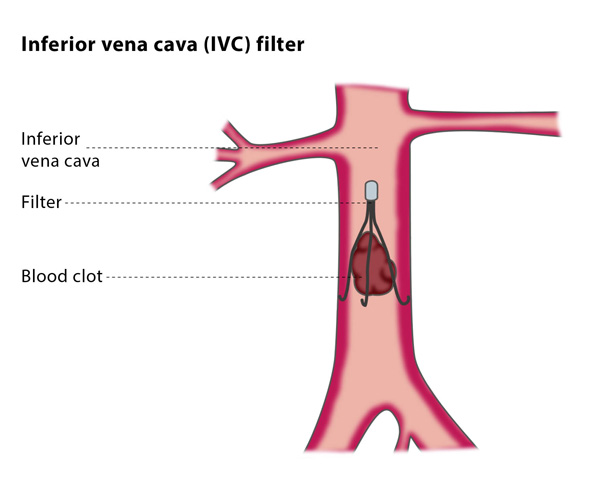IVC Filter Placement: An inferior vena cava filter also known as IVC filter is a sort of vascular filter that is inserted by interventional radiologists or vascular surgeons into the inferior vena cava to likely prevent life-threatening pulmonary emboli. The IVC filter effectiveness and safety profile are not well established, and in general, they are only suggested in some high-risk scenarios.
The IVC filter is not indicated to be a replacement for medical (drug-based) management of venous thromboembolism. However, in some cases where patients are at high risk of developing a clinically significant pulmonary embolus and cannot be sufficiently anticoagulated, placement of an IVC filter may be suggested.

An IVC filter is a small device that can prevent blood clots from going up into the lungs. The inferior vena cava is a big vein in the middle of the body. The IVC filter device is fixed through a short surgery.
To date, there has been entirely one randomized controlled trial study found that IVC filters reduced the incidence of pulmonary emboli but increased the incidence of deep vein thrombosis. All patients were on anticoagulation drugs during the study. Results from the PREPIC study and other studies which have shown many long-term complications of IVC filters led to the introduction of retrievable IVC filters. The first retrievable IVC filters were approved by the FDA in 2003 and 2004.
In 2012, the American College of Chest Physicians suggested IVC filters for those with contraindications to anticoagulation who either become acute pulmonary emboli or acute proximal (above the knee) deep vein thrombosis.
The IVC filter was first performed by Kazi Mobin-Uddin, MD who published his verdicts in 1969 in the New England Journal of Medicine. The Mobin-Uddin filter was next succeeded by the Greenfield filter designed by Lazar Greenfield which became a lower rate of filter-related complications.
Indication of an inferior vena cava filter placement
You might need an IVC filter if you have the pulmonary embolism, or have had either of these in the past. You might need an IVC filter if you have a high risk of getting a DVT. Anything that reduces the movement of blood through your veins raises your risk of DVT.
A blood-thinning medicine such as warfarin is also used to treat people who are at risk of pulmonary embolism. Blood thinners may be used alone to prevent pulmonary embolism. But in some cases, they may be used along with the IVC filter.
In these cases, your healthcare provider may instead advise an IVC filter alone to protect against pulmonary embolism.
It’s necessary to note that IVC filters do not guard against DVT. The IVC filter helps to protect you from a life-threatening pulmonary embolism if you become a DVT.
Compression Stockings: Medical uses & Contra-indications
IVC Filter Placement Benefit & Risks
Benefits
No surgical incision is required—only a minute cut in the skin that does not have to be stitched.
The IVC filter has a high rate of success in guarding lungs against serious pulmonary embolus in victims who become failed conventional medical therapy or cannot be provided conventional medical therapy.
Risks of an inferior vena cava filter placement
All procedures have risks. The risks of this procedure include-
- Any procedure where the skin is perforated takes a risk of infection. The risk of infection needing antibiotic treatment seems to be less than one in 1,000.
- There is a slight risk of an allergic reaction.
- Damage to the blood vessel at the infusion position and causing bleeding.
- Blockage of blood issue within the vena cava, which can induce leg swelling.
An IVC filter that travels to the heart or lungs, provoking injury or death.
There is a possibility that the IVC filter can lodge in the wrong place, that penetrate through the vein, can rarely lead to injury of a nearby organ.
How does the IVC filter Place
Applying image supervision, a catheter is inserted into the skin within a large vein in the neck or upper leg and pushed to the inferior vena cava in the abdomen. Contrast element will be inserted into the vein to assess for proper positioning of the IVC filter. The IVC filter is then put in the catheter and into the vein. Once it is in the exact position, the interventional radiologist or vascular surgeon will release the filter, enabling it to fully expand and attach itself to the walls of the blood vessel.
How does the IVC filter Remove
To remove the IVC filter, a special catheter is entered into a large vein in the neck or groin and pushed to the site of the filter in the vena cava. A removable IVC filter has a tiny hook or knob at one end that permits the catheter to capture the filter, close it, drag it into the catheter placed later withdraw it from the body.

